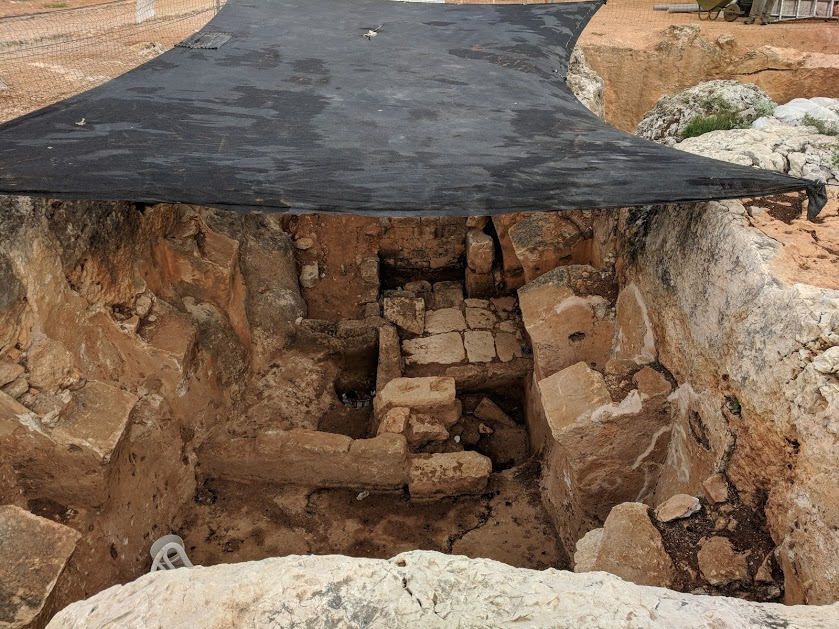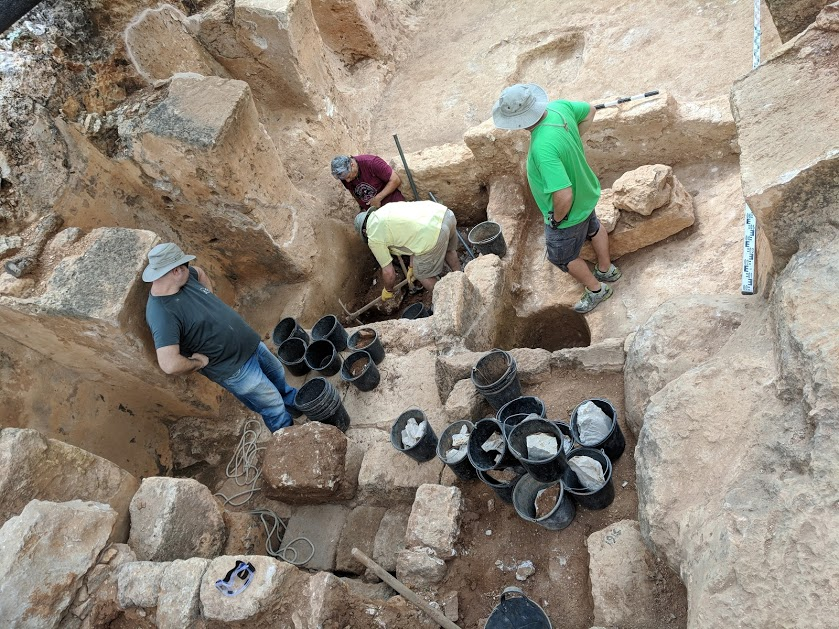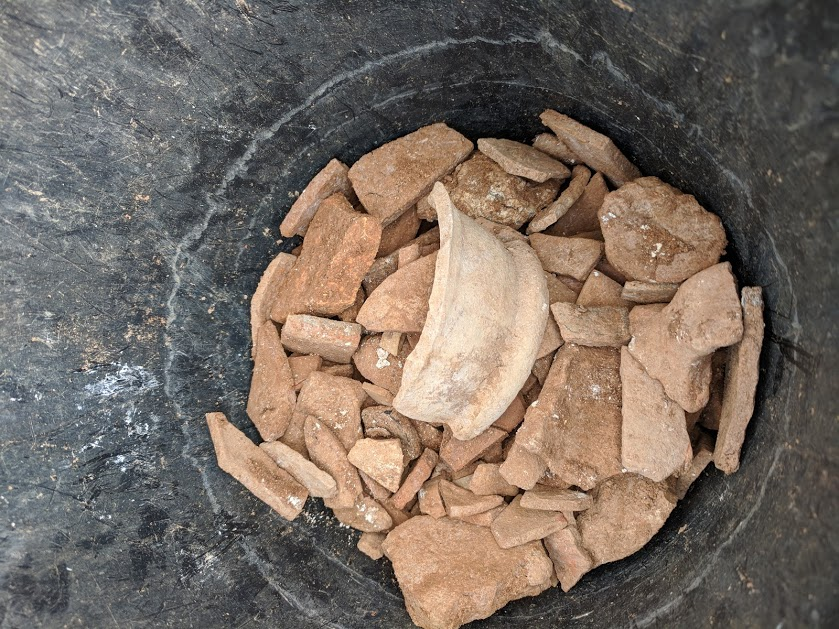In the past week I have participated in two archaeological projects.
 |
| The Water Project at Tel Gezer |
The first was at Tel Gezer, where I was asked to clean the steps leading down into what is known as the water project.
 |
| Cleaning the steps going into the earth |
The steps, which are over 4,000 years old are made of soft limestone, and chip easily. The work involved careful brushing or lifting dirt with a mini mattock to remove all but surface level dirt, or to reveal the limestone step.
 |
| Looking up the steps into the city |
The second project was at the first century Arches Reservoir at Sippori.
 |
| Information about Arches Reservoirs |
Our project at Tsippori began with trash removal and then sweeping surface areas which had been recently excavated in order to obtain archaeological photographs.
 |
| Looking into the Cistern when we arrived |
These pictures were taken in the early morning to lessen shadows created when the sun is high in the sky.
 |
| Archaeological Photography |
After the pictures were taken, a tarp was spread and tied over the Arches Reservoir to provide shade as we worked.
 |
| Spreading a tarp for the workers |
I was asked to remove dirt from a basin in the southern room of the central section of the former cistern (tank which was built for holding the community’s water).
 |
| Two Cisterns, our dig is to the left |
It is thought that water was brought through channels (or aqueducts) from springs along the ridge of the Nazareth Mountains. When the Arches Reservoirs were first built in the days of Herod Archelaus, the cisterns were filled with water for the population of Sipporus.
 |
| The dig is a project of Moskau Institute of Archaeology |
For the work in the bowl like hole in the floor I used a trowel to lift dirt, inspect its contents and put it in a bucket for removal. Some of the fill dirt in this project was rich in pottery, which, when found, we placed in a special pottery bucket.
 |
| The room under the tarp |
When the bowl was cleaned, was moved into a room on the northern side of the central area of the cistern. This small room (perhaps 6’ x 6’) was one of the areas of major focus for our dig. I worked my way down through the dirt between large rocks which had collected into the square.
 |
| A picture taken to the west in the cistern |
Late in the morning Dr. Tsvika Tsuk, chief archaeologist at the Israel Nature and Parks Authority looked at the room and identified the large rocks as blocks of the arches which had fallen. The roof structure was held up by Roman arches with stone crossmembers. These collapsed at some time during the cistern’s 2,000 year history.
 |
| Removing large rocks in the Cistern |
The large blocks used for arch construction were salvaged and moved into the southern room of the cistern. They will be numbered and removed at a later date by crane. The other rock in the hole was demolished so it could be put into buckets and lifted to a ground level area designated for rock removal.
 |
| Rocks labeled for reconstruction of the Arches |
When the rocks were removed (and when subsequent rocks were removed), each of the diggers in turn removed more dirt from the room. Eventually we went down four or five feet below the beginning surface and revealed two steps into the room.
 |
| The dig in progress |
We also worked on dirt removal in an area on the western end of the cistern. The dirt was sandwiched between a newer wall and the original southern end of the water reservoirs. Six to eight feet of dirt was removed from this area, and we found (after three days of digging) the original cistern floor.
 |
| A group visiting from Atlanta, GA |
During one afternoon at the dig, a tour group (known to our leaders) came and participated in the dig. All enjoyed the activities and the finds.
 |
| Close-up of central rooms in the Cistern |
Picks (called a mattock) and digging hoe were used to loosen large amounts of dirt and to scoop it into the little black buckets. As the work progressed, I became part of a chain which lifted dirt out of the hole. After the dirt reached the surface area it was placed in a wheelbarrow, and dumped into areas designated for each part of the dig. During the last two days of the dig I was the designated carter and dumper.
 |
| A new use for black archaeological buckets |
After the dirt was dumped, one of the archaeologists would come to each pile of dirt and examine it for metal. He discovered lots of nails and a few coins.
 |
| Workers near the end of the project |
We also found Roman glass, roofing tiles, a mosaic block, and plaster.
 |
| Bucket of recovered pottery |
Each day the archaeologists would speak about findings. They continued to think about what was found after they went home, and shared developed ideas each morning.
 |
| Coin from the Arab period |
There were two layers of plaster in the cistern. The first was grey and the second was pink. Some of the stones were placed in front of the first century grey plaster for a later use. The new wall of rocks at the southern end of the cistern had no plaster.
 |
| Measuring the depth of the hole |
The concept that emerged was that the Arches Reservoir had three uses. The first was to hold water (first century). After new cisterns were developed for a growing population, the cistern developed into a wine press. Grapes were stomped in the square box in the floor on the eastern room of the cistern.
 |
| The "new" second century cistern |
A drain was found leading into the square box into the central room (northern side with two steps) that drained and retained the grape juice.
 |
| Surveying the dig |
In the fifth century (dated by coins we found) stairs were built down the western wall of the cistern. The underground room became a prison, house or was used for some other purpose. Tiles were placed on top of the cistern plaster in the western room by the stairs.
 |
| A final picture of our dig at Tsippori |
At the end of the project surveyors came to document everything, a coin specialist visited, the pottery was washed, and the Arches Reservoirs were photographed.
 |
| Washed Pottery |
All of the findings will be studied and documented. Eventually a report will be written and shared so other archeologists can understand and use the findings.



Hi
ReplyDeleteHi
ReplyDeletethanks for the blog!
kindly visit the link for more details about us:
dirt removal north vancouver